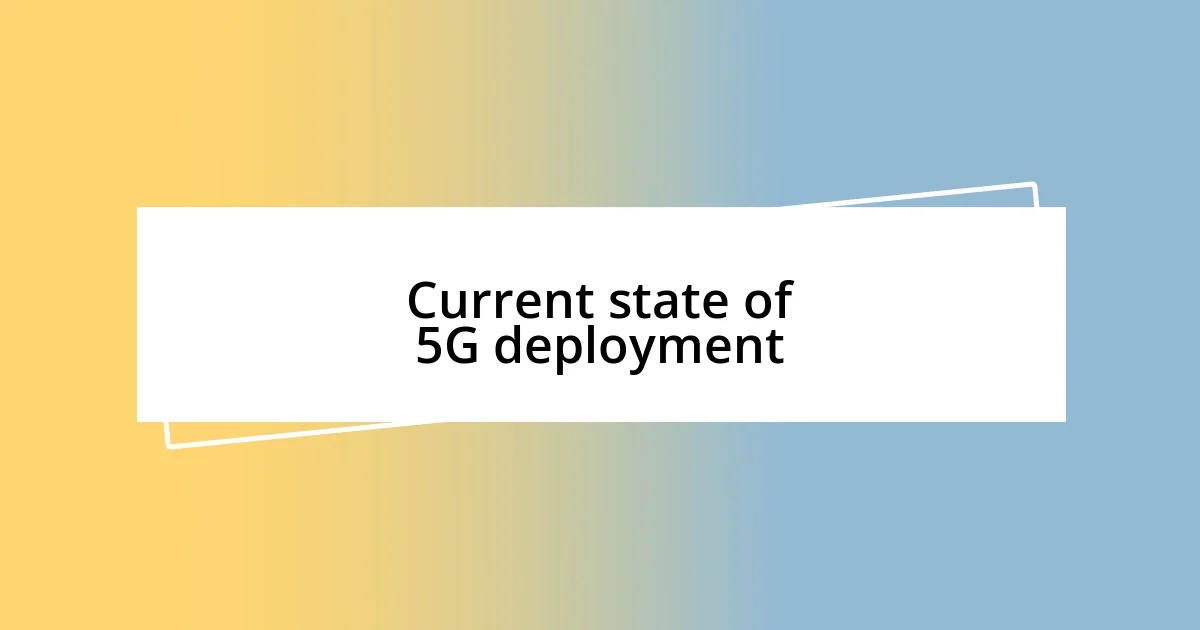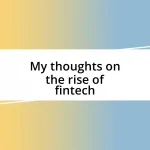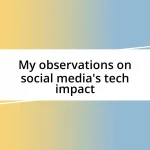Key takeaways:
- 5G technology offers improved speed, reliability, and low latency, transforming daily connectivity and enabling innovations like AI-assisted surgeries and smart homes.
- The current state of 5G deployment shows rapid infrastructure growth in urban areas, but challenges remain in rural access, technology complexity, and consumer awareness.
- Future trends in 5G include network slicing for tailored experiences, integration with AI for smarter cities, and advancements in AR/VR applications, redefining urban living and connectivity.

Understanding 5G technology
5G technology represents a significant leap forward in mobile connectivity, promising faster speeds and more reliable connections than ever before. I remember the first time I experienced it in action; I was at a bustling café, and streaming high-definition videos felt nearly instantaneous. Isn’t it thrilling to think about how this technology can transform the way we live and work?
One of the most remarkable aspects of 5G is its latency, or the delay before a transfer of data begins following an instruction. With latencies as low as one millisecond, this technology enables real-time interactions—imagine AI-assisted surgeries or self-driving cars communicating seamlessly with each other. It raises intriguing questions about our reliance on technology: how much trust are we willing to place in these automated systems?
Further enhancing its capabilities, 5G also supports a significantly larger number of devices simultaneously. In my own neighborhood, I’ve noticed how smart devices are becoming commonplace, from smart lights to home security systems. Have you ever thought about what our homes will look like with every gadget, from your refrigerator to your thermostat, communicating in harmony? The possibilities are truly exhilarating.

Current state of 5G deployment
As I delve into the current state of 5G deployment, I see a landscape that’s evolving rapidly but still has some way to go. Many major cities around the globe have witnessed 5G networks being rolled out, leading to an exciting wave of new applications and services. Just last month, I visited my friend in a newly upgraded area. We were amazed at how much quicker downloads were compared to 4G—streaming music and games felt seamless.
Here’s a snapshot of the current deployment status:
- Major telecom companies are ramping up their 5G infrastructure, focusing on urban areas.
- Expansion includes rural regions, though coverage gaps still remain in many places.
- Many smartphones now support 5G, but consumer adoption is still growing slowly.
- The technology is being used across various sectors, from healthcare innovations to smart cities.
- There are ongoing discussions about the environmental impacts and safety implications of 5G technology.
Looking around, it’s clear we’re just scratching the surface. I often think about the small changes I can already see in my day-to-day life. For instance, it’s remarkable how quickly my devices connect and communicate now. I can hardly wait to see where we will be in the next few years!

Benefits of 5G for consumers
The benefits of 5G for consumers are numerous and transformative. One immediate advantage I’ve noticed is the incredible speed it offers compared to 4G networks. Just the other day, while waiting for a video to buffer, I couldn’t help but appreciate how quickly it loaded—I barely had to wait at all. This kind of speed can enhance our everyday experiences, whether it’s downloading large files in seconds or enjoying uninterrupted streaming on multiple devices.
Moreover, with the improved reliability that 5G provides, I find that my connectivity issues at crowded events significantly decrease. I vividly recall attending a concert where the crowd was overwhelming, yet I was able to share my experience in real-time with friends via social media without a hitch. This kind of seamless sharing enriches our social experiences and keeps us connected, no matter the circumstance.
Lastly, 5G’s capabilities extend beyond speed; it opens the door for innovative applications. I’ve seen remarkable advancements in augmented reality (AR) experiences through 5G, which have made exploring new locations more interactive and fun. Imagine walking through a historic district and using AR apps that provide real-time information about the sights around you. These experiences not only enhance our daily activities but also foster a deeper connection with our surroundings.
| Benefit | Description |
|---|---|
| Speed | Faster upload and download times compared to 4G, enhancing media consumption. |
| Reliability | More consistent connectivity in crowded areas, improving social sharing experiences. |
| Innovation | Enables new applications like augmented reality for richer interactive experiences. |

Impact of 5G on industries
The impact of 5G on various industries is nothing short of revolutionary. I recently read about how the healthcare sector is embracing this technology, particularly in remote surgeries. Imagine being able to perform a procedure from miles away with real-time video feeds that are crystal clear—it’s a game-changer. I can only imagine how less stressful it would be for patients to receive top-notch care without being confined to a hospital bed.
In the manufacturing realm, I’ve seen examples of increased automation and efficiency due to 5G connectivity. For instance, factories can utilize smart sensors that communicate instantly about machinery health, preventing costly downtime. Reflecting on this, I wonder how many industries will completely reinvent their processes, inspired by the possibilities that 5G brings. It’s thrilling to think of the innovative solutions that could emerge as a result.
Moreover, I came across some insights on 5G’s potential role in agriculture. Farmers are starting to use smart drones for crop monitoring, which allows for precision farming like never before. What struck me was how this technology can lead to better yields and sustainable practices. It’s touching to see how 5G can influence not only our economic landscape but also positively impact the environment. Can you imagine a future where technology nurtures our planet in ways we haven’t even anticipated yet?

Challenges facing 5G adoption
When I think about the challenges facing 5G adoption, the first thing that comes to mind is the significant infrastructure costs. It’s a hefty investment for telecom companies to upgrade their towers and technology to support 5G. I remember chatting with a friend in the industry who explained how some small providers struggle to keep up because their budgets simply can’t match the major players. This disparity can lead to unequal access, which is a real concern for rural areas that often feel left out.
Another hurdle is the complexity of 5G technology itself. Unlike previous generations, 5G relies on a higher frequency spectrum, which means shorter wavelengths that can struggle to penetrate buildings and obstacles effectively. Recently, I had a conversation with a tech-savvy neighbor who shared his frustration about dropped calls when indoors. His experience perfectly illustrated how, despite the promise of faster speeds, the actual day-to-day connectivity remains inconsistent.
Lastly, there’s the issue of consumer awareness and trust. Many individuals still don’t fully understand what 5G offers or may have concerns about health implications associated with increased exposure to electromagnetic fields. I often find myself trying to clarify these misconceptions during family gatherings. Have you ever noticed how the mere mention of 5G often stirs up anxiety? This challenge emphasizes the need for education and outreach. Ultimately, it’s vital that we bridge this knowledge gap to encourage broader acceptance of this innovative technology.

Future trends in 5G development
As I envision the future trends in 5G development, one pivotal aspect that stands out is the transformative potential of network slicing. This technology allows operators to create multiple virtual networks within a single physical 5G network. I recall a recent discussion where we envisioned how, in sports stadiums, one slice could offer exceptional bandwidth for fans streaming from their seats, while another could be dedicated to critical operations like security management. Isn’t it exciting to think about the tailored experiences that 5G can provide, shaping our daily activities in ways we never imagined?
Looking ahead, I can’t help but think of the increased emphasis on integration with artificial intelligence (AI). I recently read a fascinating article highlighting how AI can optimize traffic management systems using real-time data from 5G networks. Imagine cities where traffic lights adapt instantaneously to changing conditions, significantly reducing congestion. This symbiosis of technologies could create smarter, more efficient urban environments. But it also raises questions: How will our relationship with our cities change when technology evolves to understand us better?
Another trend I foresee is the expansion of 5G into various consumer applications, such as augmented reality (AR) and virtual reality (VR). I often think back to the time I tried a VR headset for the first time. The experience was transformative, but limited by my home’s connection speed. With the speeds of 5G, I can only imagine the immersive worlds we could explore together, making gaming and social interactions even more vivid. Doesn’t that sound like a dream come true? Overall, the future of 5G development is poised to redefine not just how we connect but also how we experience the world around us.

Exploring 5G and smart cities
When I delve into the intersection of 5G and smart cities, I can’t help but feel a mix of excitement and curiosity. I often think about the imaginative possibilities that arise when robust connectivity is woven into urban environments. Picture this: sensors on every street corner collecting data on air quality and traffic patterns. This isn’t just a futuristic dream; it’s the reality that 5G promises. I remember walking through a city park and noticing how smart benches are already popping up, equipped with charging ports and Wi-Fi. Can you imagine how much smarter and more user-friendly our cities could become?
Moreover, the opportunities for enhancing public safety really strike me. With the instantaneous data transfer capabilities of 5G, emergency services could respond to incidents almost in real-time. I remember reading about a fire department that could receive alerts from smart smoke detectors long before the fire truck even left the station. What if every city could implement such systems to save lives or prevent disasters? It’s not just about convenience; it’s about creating safer places to live and work.
Then there’s the impact on urban planning. I often ponder how architects and city planners will leverage 5G to redesign spaces that adapt to the needs of their inhabitants. Imagine urban traffic systems that evolve based on real-time usage, or lighting that adjusts according to the number of people present. I once spoke with a friend who works in urban design, and her eyes lit up as she described her vision of walkable neighborhoods interconnected by public transport driven by 5G data. Doesn’t that ignite your imagination for what’s possible? The fusion of 5G technology with smart city planning truly has the power to redefine our urban experiences.












